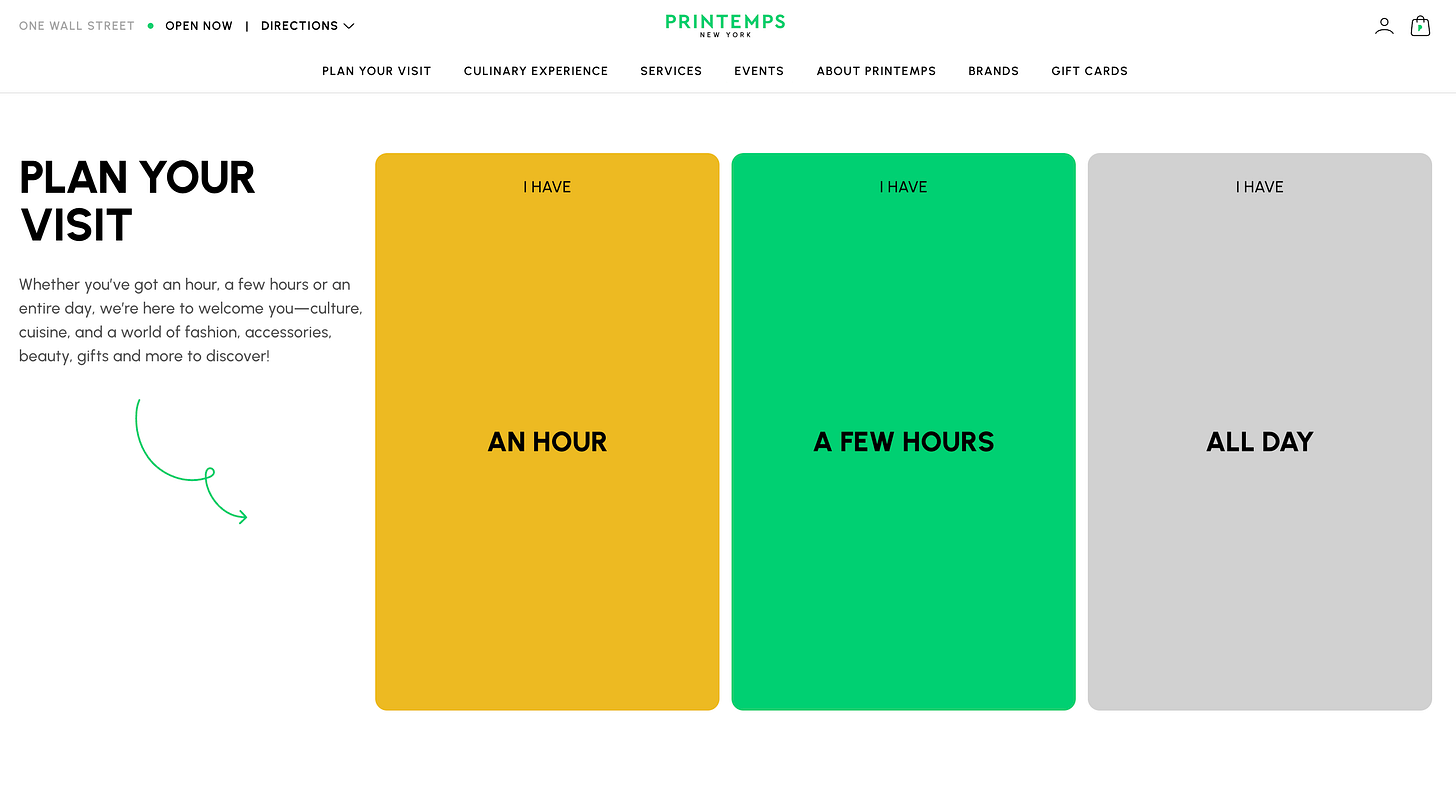Time well spent is the KPI hotels must track
At its core, hospitality is a business of time allocation.
Every city has a neighborhood that locals avoid at all costs. In Amsterdam, it’s the Red Light District, full of drunk Brits and weird lurkers, slowing down the bikes. In Paris, it’s a stretch of road between l’Opéra and Saint-Lazare train station. Along this street sit more than 100,000 square meters of retail, packed with the most prestigious brands. A paradise for tourists and suburbanites, a living hell for any Parisian. Rumor has it Chinese tour buses stop in front of Printemps and bribe passengers to go inside and buy Louis Vuitton items, since there’s a “one item per sale” rule enforced for Asian tourists.
Les Grands Magasins (Printemps & Galeries Lafayette) are full of tourists and poor design decisions. Every year, the Christmas windows elevate the outside, but the inside remains austere: rack after rack of clothes, with one goal, sell as much as possible. However, Paris knows how to make a great mall. Look at the newly reopened La Samaritaine or the Left Bank’s Le Bon Marché. Those places, a tad smaller, choose to display less, but better. La Samaritaine’s champagne bar probably inspired Printemps’s New York outpost.
Because yes, if you haven’t heard, Printemps opened its first American location in New York this year. The avalanche of press coverage made it hard to miss. But this time, the star of the show is the food. Every article is quick to highlight the five restaurants under the direction of Chef Gregory Gourdet. The website tells the story even better: while the Paris site is bulky and transactional (you get practical info), the New York one is built around a journey. A journey organized around time.
Why does it matter
At its core, hospitality is a business of time allocation. Every guest who steps into your venue is making a conscious decision: I’m giving you this much time, what will I get in return? It could be two hours for a lunch meeting or a weekend in a suite, whatever the case, guests are offering you their time in exchange for an experience, an outcome.
And yet, hospitality rarely measures time as its true currency. Hotels track revenue per available room. Restaurants measure table turnover. Reservation systems lead with the same blunt question: When? When are you checking in? When are you dining? The focus is on the date and the slot, not on how they want to spend their time while they’re there.
But time shapes everything. That’s why every sales call begins the same way: “How much time do you have for this call?”, because knowing the answer changes the conversation. If there’s an hour, you can dive deep; if there’s fifteen minutes, you cut straight to the essentials. The same principle applies in hospitality: if you knew exactly how a guest wanted to allocate their time, you could craft an experience that honored it. You wouldn’t upsell dinner reservations to someone arriving late and leaving early. You wouldn’t push spa packages on a guest who’s staying just long enough to sleep.
Restaurants already know the importance of time, though some often weaponize it against the guest. Instead of asking diners how long they’d like to stay, they set the clock themselves, subtly (or not so subtly) pushing you out so they can seat the next table. There’s nothing more frustrating than being rushed through dessert because they need the table back. The opposite is also true, there’s nothing worse than a business dinner dragging on endlessly because the plates arrive late and conversation dries up. There’s only so much you can say about the weather.
What if hospitality saw itself not as selling beds or meals or square meters, but selling time allocation? Selling a block of time, carefully hosted and designed. Reframing the goal from transactional to emotional. It invites hospitality to design experiences around time well spent, not just money well spent. It opens the door to thinking beyond the immediate service, recognizing that what happens before, during, and after a stay all belong to the same continuum of care.
If you’ve enjoyed this, feel free to pass it along to someone who might too. I don’t follow a set schedule here, sometimes it’s once a day, sometimes once a month, but when something’s worth sharing, I’ll hit send. Thanks for reading.




Great ideas. In Prague it’s Charles bridge 🙈😅
In SF: Fisherman’s Wharf and Union Square.
I’ve always been intrigued by the things that both tourists AND locals love. Here it’s the Ferry Building and The Presidio.
I love your KPI idea, but how might you actually measure it in practice? Is there a decent proxy that’s more easily measured?